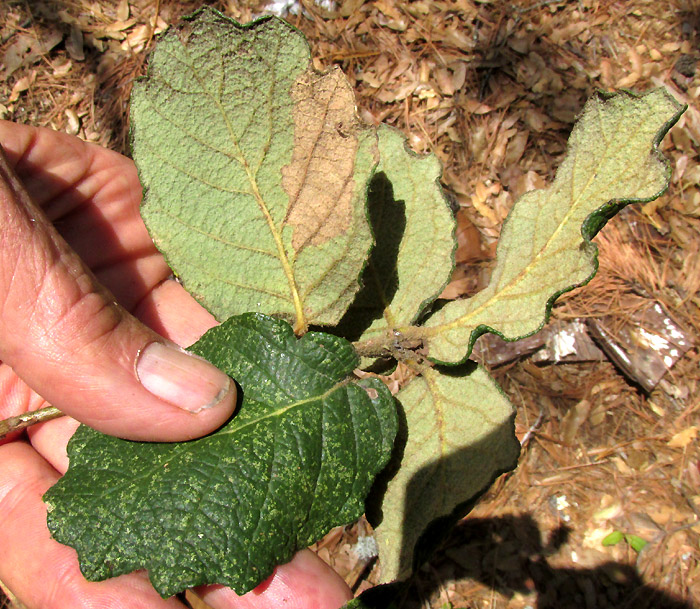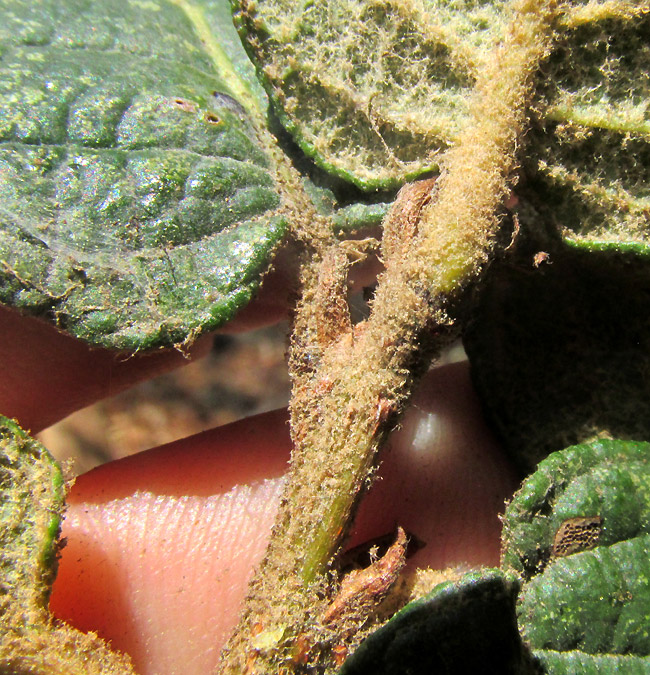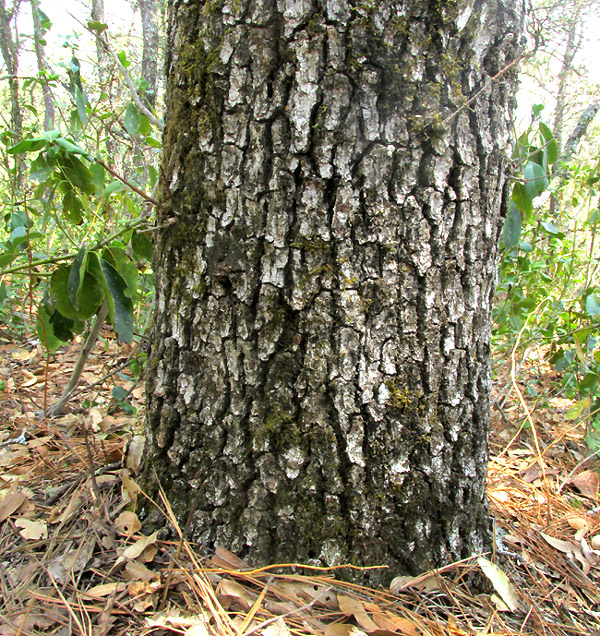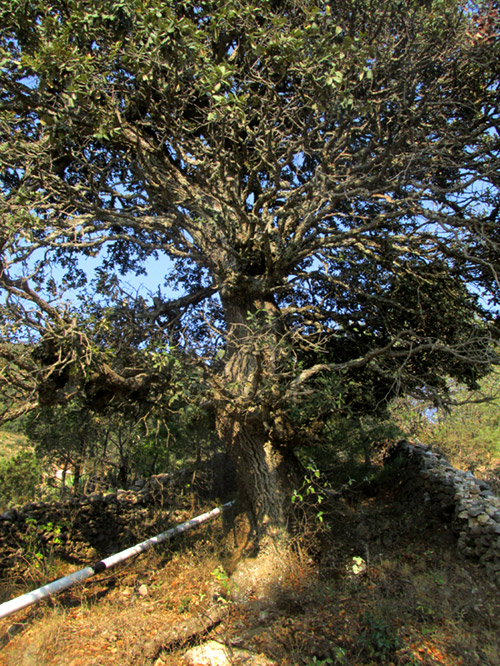Excerpts from Jim Conrad's
Naturalist Newsletter
Entry from field notes dated May 7, 2023, atop hill forested with pines and oaks about 1km east of Curva de la Doctorcilla, on unnamed road connecting Hwy120 and El Doctor; limestone bedrock; elevation ±2650m (8700 ft); Eastern Sierra Madre mountains of east-central Querétaro state, MÉXICO, (N20.88°, W99.62°)
QUERCUS LAETA

Atop a forested hill on which the pines were dying or already dead because of bark beetles, an oak maybe 20 years old produced the above leaves. Oaks comprise one of the most species-rich tree genera, Quercus, and Mexico is the Earth's center of oak diversity. Moreover, it's amazing how many of Mexico's oak species produce somewhat leathery leaves lacking deep lobes, like the above, plus often there's plenty of leaf variation among the individual look-alike species. Therefore, if you're visiting new places and you find an oak with leaves vaguely like the above, and you want to know which oak it is, you just have to "do the botany" -- pay close attention to details.
Important field marks to note on the above is the leathery leaves' dark, wrinkled upper surfaces and much paler undersurfaces. Leaf petioles are short, and blade bases can be rounded or even develop backward directed lobes. Blade margins are irregularly wavy with shallow sinuses between modest lobes. Blade secondary veins either do or don't end as weak cusps or "mucros." Six or so secondary veins arise from leaf midribs, and the leaves themselves are smallish, about 7 or 8cm long (2½ inches).

Leaf undersides were very hairy with branched hairs matting with neighboring ones. Veins on blade upper surfaces were sunken into the blades, and the blades themselves were rough to the touch.

Beneath the tree the above acorns were hard to find, their nuts much desired by wildlife. The cups were especially deep, the single acorn still in its cup about half overgrown by the cup. One acorn at its tip exhibited a slight point, or mucro. Acorn cup scales narrowed toward their tips.

The trunk's bark was dark gray, and a general feature of this species at this location was that leafy sprouts arose all along the trunk, even at the base, as seen above.
Later, on a steep slope beside the gravel road in the valley below, the tree shown below was strikingly larger and more developed than others in the area. My guess is that it was a relict roadside tree from a time before the entire hill had been deforested, maybe spared for its shade. It's shown below:

The tree was inaccessible for a closer look, but leaves blown onto the road appeared to be from the same species documented above, from atop the hill. Above, notice how the trunk produces an unusual number of closely packed, gnarly branches. Could this be linked to the prolific sprout production on trunks atop the hill? A telephoto shot showed revealed what the big tree's leaves looked like:

These leaves show variations in leaf margin on the same branch. Some leaves have no or only one or two pointed shallow lobes, while the blade tip entering from the top shows four distinct points just at the tip. The leaves are much paler on the bottom surface. Also notice that this tree's branches are somewhat thick, and some year-old branches, as at the picture's lower left, are scaly-barked. It's apparent that this is the same species as encountered above.
In our part of upland central Mexico known as the Bajío, if your oak's leaf margins are wavy, maybe with modest mucros at the tip of the leaf and where secondary veins end, the blades are heavily hairy below with branched hairs, older stems are more brown-red than yellow-gray, the blades are somewhat wide and tend to be broader above the middle than below, and the oak is a regular-size tree, not a bush lower than your head, you have QUERCUS LAETA, known by no distinctive common name.
Quercus laeta is endemic just to northern and central Mexico's upland forests, mostly on dry, rocky soils. The OaksoftheWorld.Fr websites states that "Q. laeta shows extensive morphological variation throughout its distribution, which makes it a problematic species." Often the species hybridizes with Quercus obtusata, which is fairly similar and commonly occurs in this area. Especially with our trees' smaller leaves, the ones documented here don't appear to be hybrids, though.
As with possibly all tree-size oaks, traditionally Quercus laeta has been used as wood, food, as a source for commercial tannins, and for tanning animal hides. Of course for animals the acorns constitute a tremendous source of food.
In the 2020 study by Mehdi Taib and others entitled "Medicinal Uses, Phytochemistry, and Pharmacological Activities of Quercus Species" it was found that water extracts from leaves of Quercus laeta "... exhibited high radical scavenging activity against (DPPH) and HO• radicals." Radical scavengers are compounds such as antioxidants which protect cells from danger caused by free radicals, which cells naturally produce and can accumulate, damaging molecules and possibly increasing the risk of cancer and other diseases.
In our immediate context, possibly Quercus laeta is most valuable not only for its wildlife-sustaining acorns, but also because it's a robust, adaptable species which stabilizes soil on steep slopes. It's poised to replace the massive, beetle-caused die-off of pines.